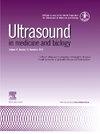Evaluation of Ultrasound Microflow Imaging as an Assessment Tool for Digital Arteries in Thromboangiitis Obliterans
IF 2.6
3区 医学
Q2 ACOUSTICS
引用次数: 0
Abstract
Purpose
Thromboangiitis obliterans (TAO) diagnosis is challenging, and arterial imaging plays a major role in identifying distal artery occlusions. The ultrasonic micro-flow imaging (MFI) mode aims to identify small vessels better using high frame rates and adapted filters. Our objective was to compare the digital arterial characterization performance of MFI with digital subtraction angiography (DSA).
Materials and Methods
We conducted a prospective single-center analysis of patients with suspected TAO to compare DSA results to MFI. Ultrasonic scanning was performed on the ten fingers with a longitudinal view using a 4–18 MHz probe. Four-limb angiography was performed following a standardized protocol.
Results
Twenty patients with confirmed TAO (median age 48 years) and seven (median age 40 years) with initially suspected TAO refuted after diagnostic work-up were included. The agreement for detecting arterial occlusion between MFI and DSA was good (Kappa coefficient of 0.83 [0.77‒0.90]). Patency of all digital arteries was found in patients who had ruled-out TAO. Qualitative alterations of the digital arteries were also noted in TAO, with non-parallel walls and a smaller, irregular diameter.
Conclusion
Ultrasound imaging using MFI mode for digital artery analysis is a promising contender to DSA for diagnosing TAO. Careful analysis allows for the detection of occlusion-recovery, flow analysis, and the detection of parietal arterial anomalies. This non-invasive examination could, therefore, become a major tool for assessing digital arteries in cases of suspected TAO.

超声微血流成像作为血栓闭塞性脉管炎指动脉评估工具的评价。
目的:血栓闭塞性脉管炎(TAO)的诊断具有挑战性,动脉成像在鉴别远端动脉闭塞方面起着重要作用。超声微流成像(MFI)模式旨在通过高帧率和自适应滤波器更好地识别小血管。我们的目的是比较MFI和数字减影血管造影(DSA)的数字动脉特征表现。材料和方法:我们对疑似TAO患者进行了前瞻性单中心分析,比较DSA结果和MFI结果。采用4-18 MHz探头对10根手指进行纵向超声扫描。按照标准化方案进行四肢血管造影。结果:20例确诊为TAO的患者(中位年龄48岁)和7例确诊为TAO的患者(中位年龄40岁)。MFI与DSA检测动脉闭塞的一致性较好(Kappa系数为0.83[0.77-0.90])。在排除TAO的患者中发现所有指动脉通畅。指动脉在TAO中也有质的改变,壁不平行,直径更小,不规则。结论:MFI模式下的数字动脉超声诊断是DSA诊断TAO的有力竞争者。仔细的分析可以检测闭塞恢复,血流分析和检测壁动脉异常。因此,这种非侵入性检查可能成为评估疑似TAO病例指动脉的主要工具。
本文章由计算机程序翻译,如有差异,请以英文原文为准。
求助全文
约1分钟内获得全文
求助全文
来源期刊
CiteScore
6.20
自引率
6.90%
发文量
325
审稿时长
70 days
期刊介绍:
Ultrasound in Medicine and Biology is the official journal of the World Federation for Ultrasound in Medicine and Biology. The journal publishes original contributions that demonstrate a novel application of an existing ultrasound technology in clinical diagnostic, interventional and therapeutic applications, new and improved clinical techniques, the physics, engineering and technology of ultrasound in medicine and biology, and the interactions between ultrasound and biological systems, including bioeffects. Papers that simply utilize standard diagnostic ultrasound as a measuring tool will be considered out of scope. Extended critical reviews of subjects of contemporary interest in the field are also published, in addition to occasional editorial articles, clinical and technical notes, book reviews, letters to the editor and a calendar of forthcoming meetings. It is the aim of the journal fully to meet the information and publication requirements of the clinicians, scientists, engineers and other professionals who constitute the biomedical ultrasonic community.

 求助内容:
求助内容: 应助结果提醒方式:
应助结果提醒方式:


